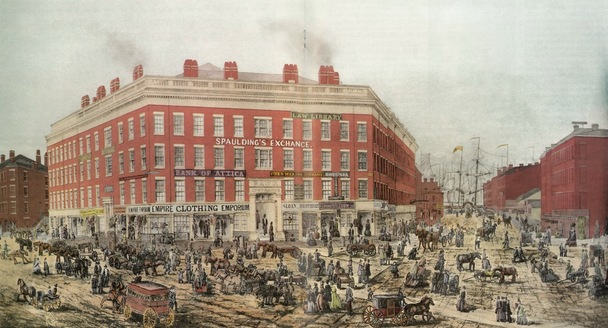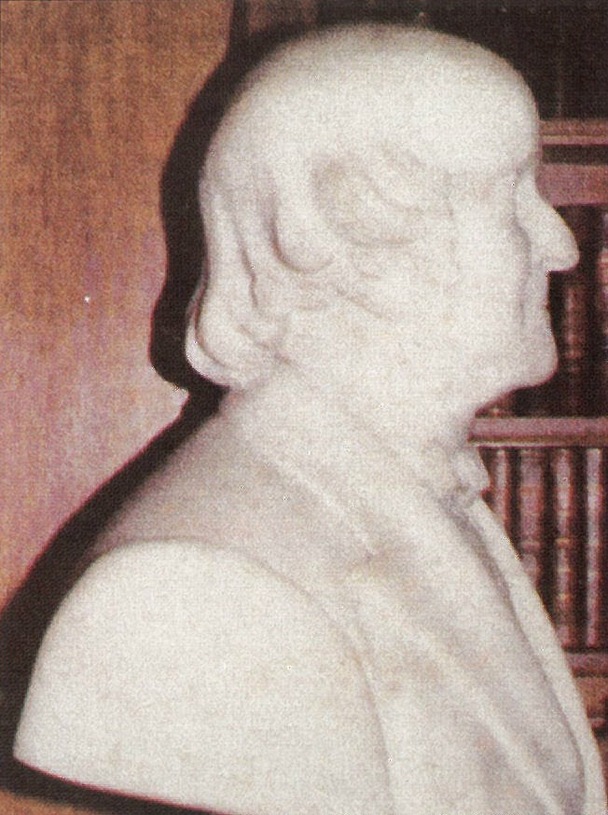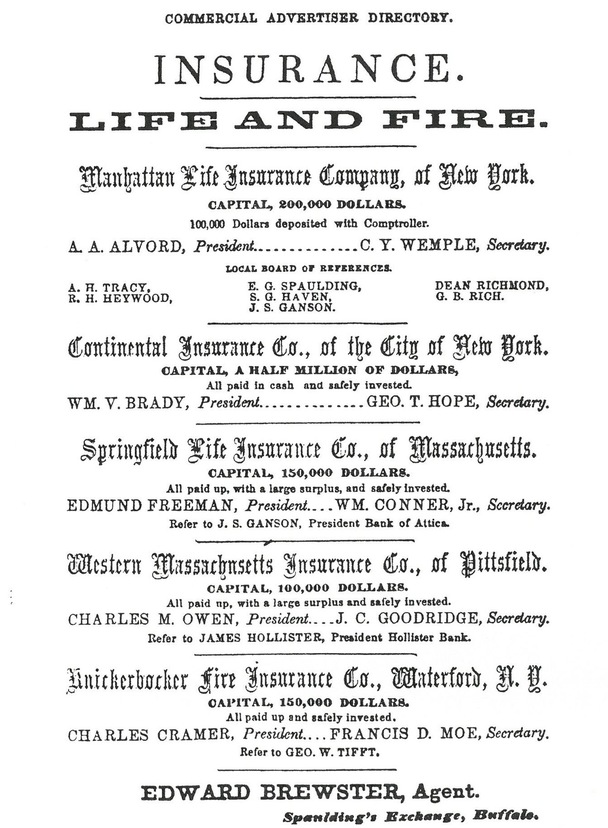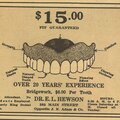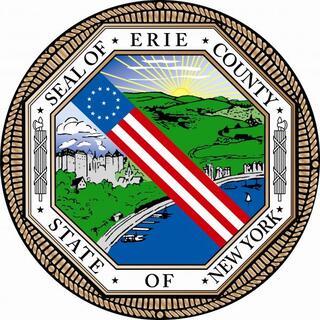The Honorable Elbridge Gerry Spauling (1809-1897) builder of Spaulding’s Exchange, an imposing brick office and retail structure located at Main Street and The Terrace intersecting Commercial Street on the west, was widely known as “Father of the Greenback.” A lawyer, financier and statesman who ranks after President Millard Fillmore and Grover Cleveland as Buffalo’s third most prominent nineteenth century figure on the national scene, he was born at Summer Hill, Cayuga County, N.Y. on February 24, 1809 and died in Buffalo, May 5, 1897. His birth date followed by only twelve days that of Abraham Lincoln, with whom he became closely associated during the Civil War years when Spaulding served in Congress. Often called Buffalo’s “grand old man,” he resided here for more than 63 years, having moved to the bustling new city from Attica in 1834, following a boyhood in Alexander and law apprenticeship in Batavia. Spaulding soon entered politics, serving successively as Buffalo city clerk, alderman and mayor. He was elected to the N.Y. State Assembly in 1848, to the U.S. House of Representatives in 1849, and Treasurer of the State of N.Y. in 1853. He then returned to Congress, serving two terms in the House of Representatives between 1859 and 1863. In 1861 as ranking member of the House Ways and Means Committee, he drafted and introduced legislation that led to the issuance of legal-tender treasury notes which circulated as paper money called “Greenbacks.” One historian has observed that “Spaulding’s financial genius was the fiscal salvation of the Union during the Civil War.” Spaulding’s duties on the Ways and Means Committee brought him into frequent contact with President Lincoln and their acquaintance grew into friendship. When Salmon P. Chase resigned as Secretary of the Treasury, Lincoln is said to have told an associate: “Were the great State of New York not already represented as it is by Mr. Seward in the Cabinet, I should at once send for Mr. Spaulding and tender him the responsible position as Secretary of the Treasury... .”
Following his retirement from Congress, Spaulding resumed a place of prominence in Buffalo’s financial and business life. In 1866 he founded the Farmers and Mechanics National Bank, and served for 40 years as its president. Also in the Exchange building was the Bank of Attica, presided over by Spaulding’s friend and relative by marriage, Gaius Barrett Rich. Spaulding was organizer and a principal of the Buffalo Gas Light Co., the Buffalo Street Railroad Co., the East Side Railroad and the International Bridge Co. which built the first railroad bridge to Canada in 1873 (still in everyday use in 2002). Spaulding arranged the necessary financing and capitalization for the bridge through New York banks. Earlier in his career (1845) Spaulding was instrumental in the development and building of Spaulding’s Exchange, a prominently positioned brick commercial complex housing offices, stores and banks. It was Buffalo’s “Main Place Mall” of the nineteenth century, located on Main Street and The Terrace, then the hub of the city’s business and commercial life. It was said to be the finest office building of its generation in the city, housing lawyers, bankers, insurance agents and real estate brokers. It was damaged and partially destroyed in an 1852 fire, but except for a few façade changes, including elimination of an elegant balustrade rail around the roof, was rebuilt substantially as before. Early Buffalo architect and builder John Harley Selkirk, whose Gas Works front exterior wall on West Genesee Street continues as a local architectural monument, was said to have been awarded the job of designed and supervising the 1852 reconstruction of Spaulding’s Exchange. An observer who once occupied living quarters in the “Exchange” commented on the building’s interior: “No tenant could ask for more imposing quarters. The wide central hall of the building is a balconied court. A wrought iron stairway circles up to the fourth floor. Wrought iron railings set off the balconies. The main hall is reached by two marble stairways.”
In nineteenth century Buffalo a strong alliance of both property and family existed between two pioneering, landowning families – the Spauldings and the Sidways – united and forged by the marriage, at First Presbyterian Church on February 26, 1866, of Charlotte Strong Spaulding to Franklin Sidway. A grand reception for several hundred guests followed at the stately Elbridge G. Spaulding mansion on Main Street corner of Goodell. Spaulding’s Exchange was but a few steps south of the Sidway family-owned Sidway Block, a four-story brick series of row buildings fronting on Main Street near the intersection of Exchange Street. The venerable, historic block existed on that site until purchased from the Sidway family by developers in 1967 and demolished as a part of downtown urban renewal, specifically the lower Main Street area surrounding what was to become the new Marine Midland Center (now HSBC).
Franklin Sidway (1834-1920) was the son of pioneer landlord and merchant Jonathan Sidway. His mother, Parnell St. John, was the daughter of Mrs. Gamiliel St. John whose frame house was the only home to survive the British army’s burning of the village of Buffalo in 1813. Elbridge G. Spaulding willed to his children, in exact portions, his enormous property holdings in Buffalo and Grand Island including his 300-acre estate “River Lawn” on the west branch shore of the Niagara River. However, his daughter Charlotte Spaulding Sidway bought out all the shares of Elbridge’s other children in Spaulding’s Exchange in the 1920s, consolidating the property into a single ownership. It was said among family members that “Aunt Charlotte brought the ‘Exchange’ with her into the Sidway family.” Title to the “Exchange” continued as “the heirs of Charlotte Spaulding Sidway” after her 1934 death, until plans for the new city War Memorial Auditorium on a site to include the “Exchange” led to extensive sale negotiations between the city of Buffalo and the owners. On February 8, 1939, seven Sidway heirs deeded the Spaulding Exchange land and building to the city for the sum of $55,000. Demolition of the brick “Exchange” building and clearing of the site soon followed the city ownership. The Buffalo Evening News on March 29, 1939 published two photos with story captions under the headline “Workers Make Way for New Hall” – interior views of the partially demolished “Exchange” revealed internal structural detail and building methods. Broken brick walls, both outer and inner, showing courses of bricks, arched masonry, wooden timber, etc., are plainly visible. The caption notes that “workmen pushed over the south wall of the old Spaulding Exchange building on the Terrace today, and most of the structure, where Buffalo history was made, is gone, making way for the Convention Hall.” Workers demolishing the long-empty 87 year old “Exchange” building in March, 1939 were amazed at the discovery of aged letters, tax records, checks, newspapers, etc. Concealed in an ancient desk and under tables in a tiny closet under rickety stairs, the documents cast a new light on the business, social and political life of Buffalo in Civil War days. In Mr. Spaulding’s own clear hand-writing were signed promissory notes, loans outstanding, records of tax payments to the city and county from 1866 to 1872, business correspondence on investments, and other items. The papers uncovered show the seasoned financier’s wealth was founded on shrewd, canny investments – his money worked successfully for him because he possessed a unique ability of knowing where to put it. However, there was an anomaly in his makeup. Mr. Spaulding possessed a strong streak of benevolence. Drawers full of promissory notes were found hidden away in the empty offices, representing debts which Mr. Spaulding had never collected. The notes were for “bad debts” on the personal loans for enterprises Spaulding considered too risky for investment by the Farmers and Mechanics Bank, of which he was president. If they were too unsound for the bank, they must have seemed bad debts for Spaulding personally. Despite this, the financier was willing to gamble his own funds, making personal loans to help the borrower. (Venture capital in today’s banking world!) Many local business enterprises, some still active today, were started with the capital which came from the Farmers and Mechanics Bank or from Spaulding himself in the form of personal advances.
